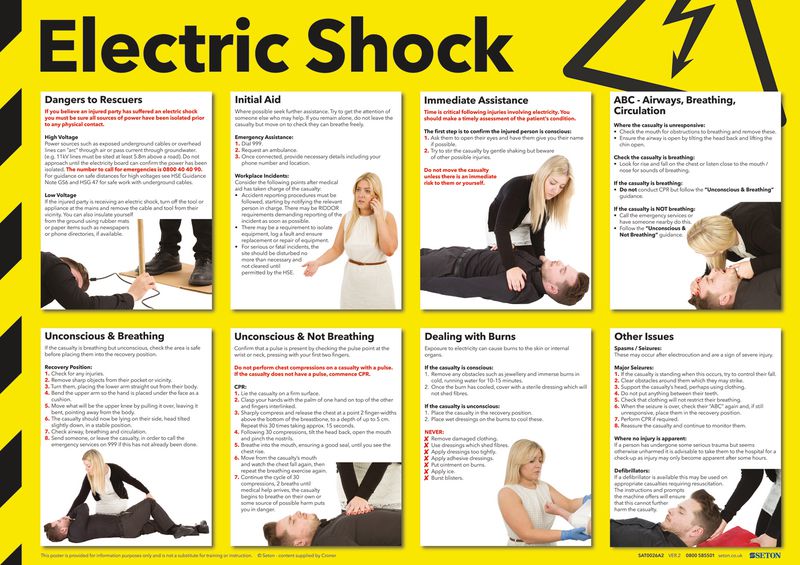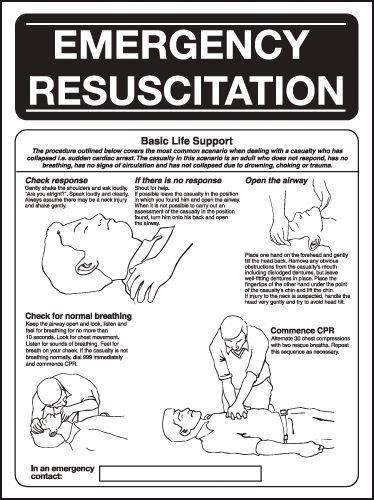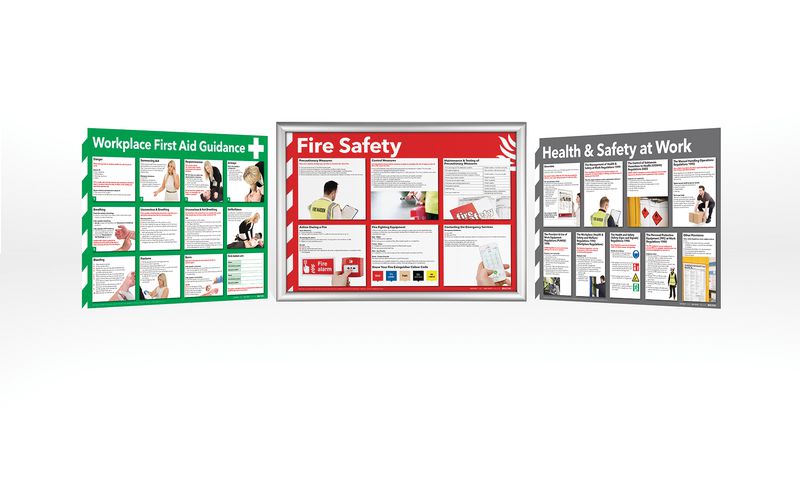-

Electric Shock Photographic Poster
From £23.99 To £30.99Supplied in: Single -

HSE First Aid For Electric Shock Poster
£13.99Supplied in: Single -
Promotion

Mediana AED Kits With Signage & Storage
From £1,229.50 To £1,760.73
From £1,028.00 To £1,556.00
Supplied in: Single kit -

Resuscitation Face Shields
£5.97Supplied in: Single -

Pocket Mask Resuscitator
£9.92Supplied in: Single -

Hot Topic Rotating Poster Kit - 12 Months
£239.99Supplied in: Single kit -

Mouth to Mouth Shield with Filter
£2.10Supplied in: Single -

Wallchart - Electric Shock Emergency Resuscitation
£17.99Supplied in: Single -

Workplace First Aid Guide Poster
From £23.99 To £30.99Supplied in: Single -

AED Responder Kit
£11.24Supplied in: Single -

Hot Topic Rotating Poster Kit - 6 Month
From £129.99 To £134.99Supplied in: Single kit -

ZOLL AED Plus® Training Defibrillator
£467.69Supplied in: Single -

Wallchart - High Voltage Electric Shock Emergency
£23.99Supplied in: Single -

Cardiac Science G5 Training Unit
£396.57Supplied in: Single -

Rebreath & Gloves in Belt Pouch
£5.65Supplied in: Single -

Face Shield in Key Fob
£57.32Supplied in: Pack of 10 -

AED Guidance Poster For Untrained Personnel
From £23.99 To £30.99Supplied in: Single -

Mediana Training Defibrillator
£539.59Supplied in: Single -

First Aid For Eyes Photographic Poster
From £23.99 To £30.99Supplied in: Single -

CPR Adult Training Pads for Cardiac Science G5 Unit
£95.11Supplied in: Single -

AED Defibrillation & CPR Poster
From £23.99 To £30.99Supplied in: Single -

ZOLL AED Plus® Trainer Bundle with AED Signage
From £573.99 To £575.86Supplied in: Single kit -

First Aid For Burns Photographic Poster
From £23.99 To £30.99Supplied in: Single -

How To Use An AED Poster
From £12.99 To £16.99Supplied in: Single -

First Aid Information Points
£55.69Supplied in: Single -

Adult Resuscitation Photographic Poster
From £23.99 To £30.99Supplied in: Single -

HSE First Aid Basic Advice Poster
£9.99Supplied in: Single -

CPR Device for Cardiac Science G5 Training Unit
£414.50Supplied in: Single -

First Aid in the Workplace Poster
From £12.99 To £20.99Supplied in: Single -

Emergency Resuscitation Portrait First Aid Wallchart
From £7.25 To £17.50Supplied in: Single -

Electric Shock Information Point
£63.99Supplied in: Single -

Hot Topic Rotating Poster Kit - 3 Month
From £76.99 To £77.99Supplied in: Single kit -

Wallchart - First Aid at Work
£23.99Supplied in: Single -

First Aid & Eye Wash Information Point
£57.49Supplied in: Single -

First Aid For Burns Guidance Poster
£23.99Supplied in: Single -

Workplace First Aid Manual
£20.49Supplied in: Single -

Snap Frame & First Aid Poster Bundle
£29.99Supplied in: Single kit -

Rebreath Training CPR Face Shield with Filter Papers
£148.71Supplied in: Pack of 10 -

Resuscitation First Aid Pack
£35.95Supplied in: Single kit -

Workplace First Aid Guidance Poster
£23.99Supplied in: Single -

Reporting Of Injuries/Diseases/Dangerous Occurrences Wallchart
£23.99Supplied in: Single -

Defibrillator Heart Restarter Instruction Poster
From £12.99 To £16.99Supplied in: Single -

Symptoms of a Heart Attack Poster
From £12.99 To £16.99Supplied in: Single -

Snap Frame & AED Guidance Poster Bundle
£29.99Supplied in: Single kit -

Cardiac Science G5 Training Pads - Adult & Paediatric
From £88.81 To £100.74Supplied in: Single set of pads -

Cardiac Science G3 Training Pads - Adults & Paediatric
From £81.58 To £93.83Supplied in: Single set of pads -
Promotion

Resuscitation for Adults Guidance Poster
£22.95
£5.58
Supplied in: Single -

First Aid For Eyes Guidance Poster
£23.99Supplied in: Single -

Chemical Spill First Aid Guidance Poster
£23.99Supplied in: Single -

First Aid For Children Guidance Poster
£23.99Supplied in: Single -

Defibrillator Heart Restarter Poster
From £12.99 To £16.99Supplied in: Single -

Wallchart - Burns
£23.99Supplied in: Single
First Aid Training Equipment
Need help?
 Get the right training materials for your site
UK Approved First Aid Training Equipment and Materials
Get the right training materials for your site
UK Approved First Aid Training Equipment and Materials
In the workplace an emergency can strike at any time, no matter how many processes you put in place. By providing first aid training equipment and supplies, you can ensure your team are prepared for any incident.
Seton stocks one of the widest ranges of first aid training supplies and props – from CPR Manikins, mouth shields and resuscitation masks, to training defibrillators and posters to aid information retention. Every workplace, including those with fewer than five employees, requires equipment and suitably trained staff. Get fast delivery on all your medical training equipment, direct from the UK’s trusted workplace safety supplier.
Also discover:
First Aid SuppliesBurns TreatmentEmergency showers/eyewash stationsFirst Aid KitsFirst Aid Room EquipmentTraining defibrillators
First Aid Training At Work - What You Need To Know
It is estimated that the correct administration of first aid could prevent as many as 150,000 deaths per year in the UK. However, close to 60% of all employees do not feel equipped to administer such medical help when needed. These figures alone reflect the urgency and importance of medical training in the working environment.
Why do I need first aid training in my workplace?
Emergency first aid at work training establishes enhanced awareness about the importance of health and safety. Providing suitable training equipment, guidance and having qualified first aiders at your business premises assures employees that you, as an employer, value their safety and wellbeing. Promoting medical training in the working environment signifies proactivity and preparedness for the unforeseen.
LIFE
SAVING
Individuals are empowered to confidently act, saving lives.
QUICKER
RECOVERY
Injured or sick workers require less time off before they can return to work.
INCREASED
AWARENESS
Improved risk management leads to fewer incidents.
BUILDS
TEAMS
Training can be a shared team experience, boosting morale.
REDUCES
WASTE
Trained individuals make more efficient use of supplies and reduce wastage.
BOOSTS
CONFIDENCE
Individuals are calmer and more confident in a crisis, helping everyone.
The benefits of first aid training in the workplace also translates to the home and community lives of employees. Building and acquiring new skills like this is essential for workers because:
- Lives can be saved - empowered staff react confidently to an incident
- Recovery times are shortened. Injured or sick employees can return to work sooner
- Safety awareness increases. As such risk is better managed and fewer incidents occur
- Working culture is improved; through team-building experiences and skills acquisition
- Material waste is lessened. Employees are better equipped to utilise first aid supplies
- Employees are calmer in a crisis. Knowledgeable employees are more confident
Of course the first step in preparing students is to provide suitable emergency responder practice equipment, supplies and guidance aids.
Can you administer first aid without training?
Whilst a degree of first aid can be administered without formal education, it is not recommended for any person to carry out such procedures without receiving formal training to ensure it is performed properly.
The NHS provides basic guidance on what to do in a wide range of situations. However this guidance includes only a basic overview and individuals would require specific training to follow some instructions. For example if a person becomes unconscious or stops breathing the NHS advises;
“If someone is not breathing normally, call 999 and start cardiopulmonary resuscitation (CPR) straight away”
Yet if none of the team is trained to carry out this technique, it is unwise to attempt to do so, as the price may be further injuries or other complications.
There is a large assortment of courses out there to teach all levels of medical aid but to provide your workers with a basic grounding in first aid principles and technique practice, take a look at the Workplace First Aid Manual. Compiled with the help of professional first aid instructors, this manual offers concise and relevant guidance on a range of common injuries and how to deal with them - with or without formal training.
Is first aid training a legal requirement?
Many business owners view first aid training as a waste of time that presents additional expense burdens. In the UK, however, it is a legal obligation.
The Health and Safety (First-Aid) Regulations 1981 detail the provisions regarding first aid in the working environment. Failing to comply will result in an investigation by the Health and Safety Executive (HSE). A business should have a first aid policy and procedures, the required equipment, and first aid-trained persons to satisfy legal requirements.
As a matter of health and safety, it should not be neglected and employers must keep in mind that they are responsible for:
- Training sufficient numbers of employees
- Additional training in the case of hazardous environments
- Adequate first aid equipment and materials on site, including signs
In addition to training, it is strongly advised that important information, such as the HSE First Aid Basic Advice Poster, are positioned on notice boards and other suitable locations throughout the business premises. Remember it is a legal requirement to display legally-compliant signs to indicate the location of first aid facilities and equipment.
How many trained first aiders do I need?
In the first instance, you should consult your first aid risk assessment. This document will indicate whether you must have an individual formally trained in first aid - also known as a first aider.
From a legal perspective you are required to have an “appointed person” as a minimum. It is not essential for this person to be first aid trained but they are responsible for making suitable arrangements - such as ensuring first aid boxes are available, that first aid supplies have not expired and calling the emergency services when required.
The role of this appointed person includes looking after first-aid equipment and facilities and calling the emergency services when required. They can also provide emergency cover where a first-aider is absent due to unforeseen circumstances (annual leave does not count). An appointed person does not need first-aid training.
An appointed person is not necessary where there are an adequate number of appropriately trained first-aiders.
First Aid At Work - Your Questions Answered
HSE
There is no legally-stipulated minimum or maximum number of trained first aid personnel required. Your first aid risk assessment will provide guidance on the number of individuals you may wish to train.
For instance the Health and Safety Executive suggests that special circumstances, such as shift work or sites with multiple buildings may require more trained personnel. Any provisions will also account for individual team member absences.
Specialist First Aid Training Equipment
First aid training for work covers an array of eventualities. Your risk assessment and health and safety plans should address the detailed training required by students. The elements covered during medical education (either taught in-house or by an external trainer) should include:
- Tending to minor ailments
- Cleaning and dressing abrasions and cuts
- Dealing with lacerations
- Performing cardiopulmonary resuscitation (CPR)
- Stabilising and splinting fractures
- Performing procedures such as the Heimlich manoeuvre
- Managing blood loss
- Managing unconscious colleagues or colleagues having seizures
- Using equipment such as defibrillators
- Managing trauma and reducing panic and shock
What equipment do you need for first aid training?
To provide emergency care coaching, alongside more everyday items such as bandages, you will require some fairly specific equipment and materials including,
- Manikins and accessories
- Face Shields
- Gloves
- Lung Bags
- Training Defibrillator
- Informational Posters
Manikins
A great way to provide cardiopulmonary resuscitation training is by using specially designed products called manikins, such as the Professional CPR Training Adult Manikin. Designed to be as realistic as possible, including an artificial skin, this manikin includes the revolutionary new CPR Rate Monitor which allows for instant feedback to both the student and their instructor. For childcare and school settings, we also supply the Child and Infant versions from the same product range.
Remember, to limit cross-contamination between users; it is recommended that manikins are cleaned thoroughly with at least antibacterial wipes, in the absence of mild soap and warm water.
 Professional CPR Training Adult Manikin
Professional CPR Training Adult Manikin
 Professional CPR Training Child Manikin
Professional CPR Training Child Manikin
 Professional CPR Training Infant Manikin
Professional CPR Training Infant Manikin
Face Shields
These products are an essential item for preventing cross-contamination between the patient and first aider during a CPR procedure. When training CPR on a manikin, we recommend the Rebreath Training CPR Face Shield with Filter Papers. Supplied as a dispensing pack of 36 shields, this is ideal for group training or for stocking in the first aid box for a real emergency. Looking for a smaller quantity? Try our Mouth to Mouth Shield with Filter which is available in single disposable packs.
While our Face Shield in Key Fob offers a practical way for first aid responders to carry a disposable shield and ensure they are always prepared to give CPR without putting themselves at risk.
Similarly the handy Rebreath & Gloves in Belt Pouch kit offers maximum protection to first aiders giving CPR. Built-in loops allow for each attachment to a belt and includes both vinyl gloves and a mouth-to-mouth face shield for use during mouth-to-mouth.
Training Defibrillator
No employee first aid training program is complete without covering the correct operation of automatic external defibrillator devices. These devices could be the difference between life and death but would your team be confident using one?
The Cardiac Science G5 Training Unit helps teach employees both how to perform CPR as well as the correct use of a defibrillator kit. The clear instructive voice commands and metronome helps guide the user through a range of rescue scenarios, suitable for cases where the patient is an adult or a child.
 Prestan Ultra AED Trainer
Prestan Ultra AED Trainer
In workplaces, schools and public places the Zoll AED Plus® device is a popular product choice. Make sure your appointed first aiders are confident using this and other AED appliances by training them with the Zoll AED Plus® Training Defibrillator. Supplied with the required accessories for students to practice alone or with an instructor.
When you are ready for the real thing, quickly get up and running, including signage and storage of your new device with the Mediana AED Kits. This pack offers a handy way to set up your defibrillator, including accessories and consumables at a price that doesn’t break the bank.
Informational Posters
Alongside the various supplies and props used in first aid training, it is important to ensure staff retain the information they have learned. At Seton we stock a full range of informational posters to offer guidance as well as reminders of key information and correct procedures.
Not sure where to start? Why not try our Hot Topic Rotating Poster Kit? This comprehensive product contains a pack of 12 posters covering topics from How to Wash Your Hands and Fire Safety to Workplace First Aid Guidance, as well as an A2 aluminium snap frame to display one of the collection. It is recommended to alternate between posters to help maintain an individual's attention when they view your notice - always seeing the same poster(s) can lead to signs blindness.
For more first aid training supplies and equipment kits, take a look at our full range of Workplace First Aid Training Kits. Order today for fast delivery, from our UK distribution centre.












